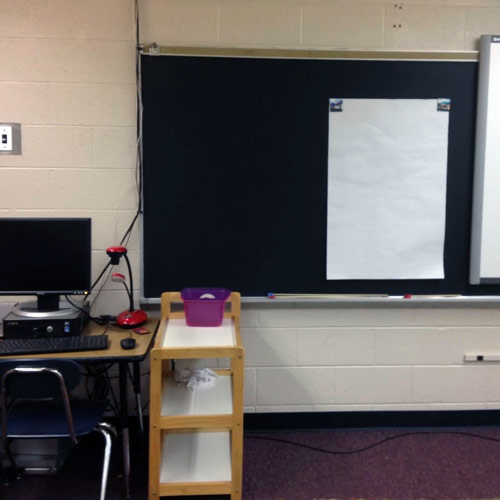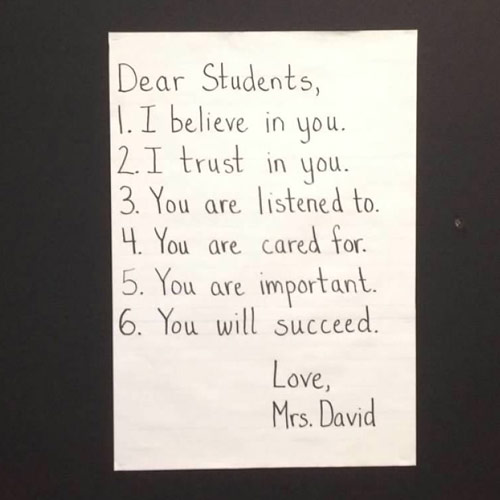EDITOR’S NOTE: This is the third installment of a four-part series about how school districts in Kent County are making the design of schools and classrooms an integral part of the teaching process. In this installment, Carol Lautenbach, a longtime educator prior to joining School News Network, examines the issues of equity involved in enhancing students’ learning spaces.
Multiple districts — It was late August in 2012. Godfrey-Lee Public Schools was getting ready for the new year and I was a new principal. I marveled as I saw buildings transformed from summer’s empty walls and dark halls to fall’s lively spaces with decorated bulletin boards, colorful rugs and labeled lockers.
Furniture was moved and swapped as class lists were perused; teachers worked together to meet the needs of all in smaller-than-optimal spaces full of resources and supplies. It was fun for me to see the joy and anticipation of teachers as they prepared classrooms for a new year of learning.
The day before students returned, I walked around the Godfrey Elementary building and checked in with teachers to be sure they had what was needed to get the year started. I knocked on the door of our newest staff member, Sarah David. When she opened the door, I was puzzled by what I saw.
Except for a rug on the floor under the front whiteboard, student desks pushed against the room’s perimeter, a tech-filled desk up front, and books and resources stacked on built-in shelves, the classroom was empty. No posters, minimal decorations. One bulletin board had a sheet of white chart paper on it, a welcome letter to students signed “Love, Mrs. David.”
“You are wondering what’s going on, right?” she asked, sensing my surprise.
“Is everything okay? Do you need anything?” I asked.
“Just my students,” she said. “Until we get to know each other, I’m not sure how they’ll want to set up the space for learning.”
Previous SNN stories on the third teacher:
• Part I: Education space, the ‘third teacher’
• Part II: Intentional spaces inspire and connect students
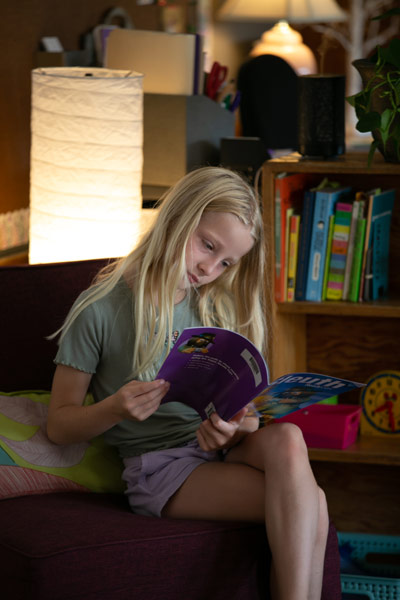
Designing Spaces for Learning Outcomes
Some innovations that intentionally incorporate “the third teacher” — the design of the space in which students learn — are very new. But preparing learning spaces for desired outcomes has been around for a long time. The bolt marks in the floor of my first classroom, scars left from the old desks that once were secured to the hardwood, were reminders of an emphasis on a mid-century “sit and get” philosophy.
Likewise, the Montessori method, founded in 1906, is uniquely designed for the outcomes expected of its educational approach. Exploration, independence, and discovery are fostered through intentional planning of the prepared environment. Although more than a century old, Montessori offers a vivid example of how the third teacher can enhance learning.
Michelle Holliday teaches fourth-, fifth-, and sixth-grade students at Grand Rapids Montessori Academy, located on Heritage Hill just east of downtown. Holliday says that while each teacher personalizes his or her space, there are common threads that run through each classroom: a home-like atmosphere, natural elements, open space, and shelves set up to encourage choice and independence in young learners.
Choices may include what to work on, which materials to use, and whom a student works with.
‘[Families] saw how an environment that is perfectly prepared allows for exploration and creates a desire to learn.’
— Grand Rapids Montessori educator Liza Hains
Holliday’s colleague, first- through third-grade teacher Liza Hain, echoed this and added an interesting twist: During pandemic virtual learning, families reached out to her to ask how to set up a Montessori environment in their homes. This was because parents saw “how an environment that is perfectly prepared allows for exploration and creates a desire to learn,” said Hain, who with her husband owns Teaching Timbers, a local Montessori furniture company.
Grand Rapids Montessori is housed in the old Fountain Elementary School, a historic building “that is beautiful and full of character,” according to Principal Kerri Reed and as seen in these photos of the spaces taken by a parent. Like many older buildings, it’s also a place where “space is always a challenge,” she said.
While the school does receive general funding in line with other GRPS theme schools, “teachers go above and beyond to set up their classrooms,” Reed said. “They find funding and use their own funds, too. We listen to teachers when new purchases need to be made.”
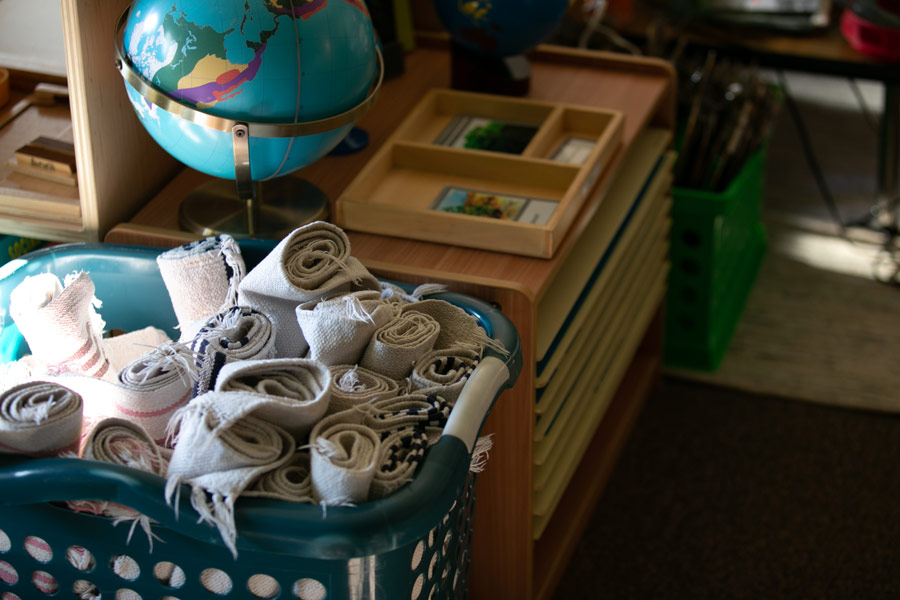
New Understandings; New Settings
I, too, learned so much from my teachers as a new principal. Before that I had been a secondary English teacher for 15 of my 29 years in the wonderful Godfrey-Lee community. I spent a lot of time as a teacher personalizing classroom spaces with photos, learning guides, student desk configurations and books. I loved setting up a space for a new year.
However, it never occurred to me to begin a year with a blank canvas for students to design for their own learning, as Sarah David did.
As my perspective broadened through 14 years of various administrative roles at the building and district level, I saw more and more educators capitalizing on the third teacher in very traditional spaces.
Some requested flexible furnishings, others decentralized classrooms by removing the teacher’s desk, and many began to think about how spaces could become student-centered through what was displayed in the halls and on the walls.
‘Until we get to know each other, I’m not sure how [students will] want to set up the space for learning.’
— Sarah David, elementary educator

We learned together about the “6 C’s” of collaboration, communication, content, critical thinking, creative innovation, and confidence. Spaces became more like workshops, with dedicated areas for collaboration and exploration and more flexible seating.
We broadened our vision to include classrooms without walls; the world outside of the classroom, from an outdoor learning center, to service learning in downtown Grand Rapids, to place-based science exploration in nearby Plaster Creek, became more common locations for students and teachers to learn in and from.
The work of school had changed, so the setting for learning had to change too. Understanding of the third teacher deepened to include, as Kendall College of Art and Design professor Gayle DeBruyn puts it, “all that you surround yourself with to support the work that you are doing.”
In my final years as assistant superintendent, I was part of a district design committee which included students and educators at all levels. We worked together to research approaches and visit other schools to identify longer-term solutions for creating spaces aligned with 6-C learning outcomes. The district shifted general expenditures and allocated grant funds to implement the committee’s recommendations.
This created a phase-in plan for new furnishings throughout the district. A recent bond-funded restoration at Lee High School includes collaborative spaces. Thanks to the dedicated work of educators, aging building environments are being transformed.
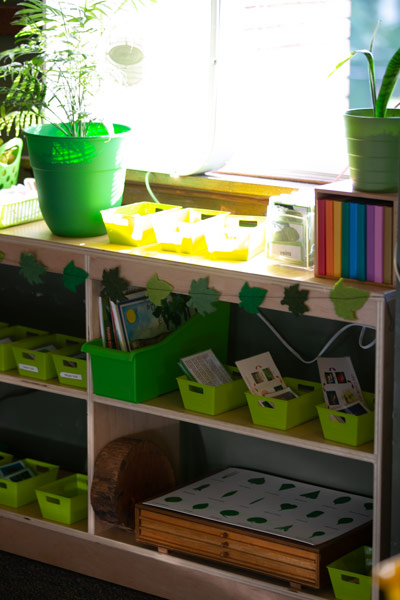
Investing in the Third Teacher at Every Price Point
However, architect Steve Hoekzema of TowerPinkster sees systemic inequities in the opportunity to fund the brick and mortar required to build spaces that align with today’s learning strengths and needs.
“Districts that have a great tax base have access to funds,” Hoekzema says. “I don’t begrudge a school district that has that (but) some don’t. I think all students deserve the best facilities. There is a huge disparity.”
There is also great potential. Godfrey-Lee, a district with a 95% free and reduced lunch rate, is not alone in its quest for equitable opportunity to transform the third teacher. As we’ve seen throughout this series, districts throughout the county are raising, using, and generating funds to transform what school is and looks like.
Learning spaces that encourage discovery, active learning, teamwork, and connections to the community can be carved out in more traditional classrooms. New construction, planned with community input, is student-centered and collaborative. Student well-being and belonging are prioritized as school spaces are evaluated and designed. And more help may be on the way.
‘Districts that have a great tax base have access to funds. I don’t begrudge a school district that has that (but) some don’t. There is a huge disparity.’
— Steve Hoekzema, architect with TowerPinkster
Kent ISD Superintendent Ron Koehler well knows the great disparity that exists in funding opportunities for creating new learning spaces.
“There are 20 million dollars in the [2022-2023] state education budget for a capital improvement study,” Koehler explains. “Each facility will be evaluated to see where they stand, using a standard that we believe is attainable and supports learning.”
The study, along with $250 million allocated to refurbish classrooms, labs, and libraries, are steps in the right direction. Additional funding would have to be allocated in the future for new learning environments in schools, depending on the extent and scope of improvement needs the study may find. Where will that money come from?
Educators in classrooms, administrators in schools, and superintendents in districts are listening to student voices as they describe what physical environment makes them feel safe, successful, and ready to create new knowledge to solve real-world problems today and tomorrow. Advocacy and a focus on equity is needed for every student to experience active, meaningful learning that leads to these kinds of outcomes.
‘When Intention Drives Design’
Sarah David now teaches third-graders at North Godwin Elementary. And she still begins the year with empty walls.
She and students work together to create charts to “reteach concepts, give ourselves reminders, and celebrate our learning together.” Students’ learning literally creates the environment and builds the classroom space she and her students share.
As we’ve seen in this installment and throughout this series, the space students learn in is not neutral; it, too, is a teacher. When intention drives design, learning outcomes are supported and advanced, whether the design is a large new build or remodel or a small change in furnishings or classroom environment.
Investing in the third teacher is investing in the future of students and society. Redesigning learning environments — for inspiration, for aspiration and for inclusion — can yield learning that lasts.
Next installment: How a new middle school building gets designed from day one to enhance learning.
Read more from Godfrey-Lee, GRPS and Rockford:
• District legislator tour kicks off more to come
• Seeing themselves in the doctor’s coat
• New 21st century furniture encourages movement, collaboration



